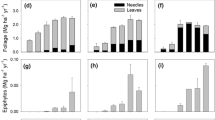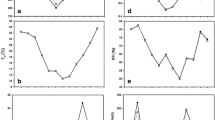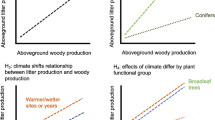Summary
Needle litterfall of a Scots pine was caught over 24 years (1962–1986) with litter-traps in a Scots pine stand in southeastern Finland. The age of the trees averaged 111 years in 1962. The stand was naturally recruited and only minor silvicultural treatments occurred during its history. Litterfall showed great year-to-year variation, the minimum being 18 g/m2 (in 1968) and maximum 213 g/m2 (in 1973). There was no overall trend in the amount of litterfall, and the age of the stand was thus not important in determining the needle fall. We used time domain time series analysis (ARIMA) and standard climatic data (temperature, precipitation) to investigate the relationship of litterfall to climatic factors. Mean July temperature was clearly correlated with needle litterfall. High temperature in July coincided with enhanced litterfall in the same and the next year. Litterfall enhanced litterfall in the same and the next year. Litterfall increased also after high temperatures during March–April, but only in the same year. In addition to these the litterfall had a 4-year self-dependency. This is approximately the same as the mean longevity of needles in the study area. Altogether the time series model we propose covers about 90% of the variance of the original time series.
Similar content being viewed by others
References
Albrektson A (1988) Needle litterfall in stands of Pinus sylvestris L. in Sweden, in relation to site quality, stand age and latitude. Scand J For Res 3:333–342
Albrektson A, Aronsson A, Tamm CO (1977) The effect of forest fertilization on primary production and nutrient cycling in the forest ecosystem. Silva Fenn 11:233–239
Bonnevie-Svendsen C, Gjems O (1957) Amount and chemical composition of the litter from larch, beech, Norway spruce and Scots pine and its effect on soil. Medd Nor Skogsforsoksves 48:111–174
Box GEP, Jenkins GM (1976) Timeseries analysis. Forecasting and control. 2nd edn. Holden-Day, San Francisco, California
Bray JR, Gorham E (1964) Litter production in forests of the world. Adv Ecol Res 2:101–158
Dimock EJ (1958) Litterfall in a young stand of Douglas fir. Northw Sci 32:19–29
Falck J (1981) Changes in the nutrient content of the vegetation and forest floor after fertilization with urea in mature Scots pine stand. Swedish University of Agricultural Sciences, Department of Silviculture, Report 5, Umeå
Flower-Ellis JGK (1985) Litterfall in an age series of Scots pine stands: summary of results for the period 1973–1983. In: Lindroth A (ed) Climate, photosynthesis and litterfall in pine forest on sandy soil—basic ecological measurement at Jädraås. Swedish University of Agricultural Sciences, Department of Ecology and Environmental Research, Report 19, Uppsala, pp 75–94
Gosz JR, Likens GE, Bormann FH (1972) Nutrient content of litter fall on the Hubbard Brook Experimental Forest, New Hampshire. Ecology 53: 769–784
Jenkins GM (1979) Practical experiences with modelling and forecasting time series. Gwilym Jenkins & Partners, Jersey
Jukola-Sulonen E-L, Salemaa M, Mikkola K (1990) The vitality of conifers in Finland 1986–88. In: Kauppi P, Anttila P, Kenttämies K (eds) Acidification in Finland. Springer-Verlag, Berlin pp 523–560
Kanninen M, Hari P, Kellomäki S (1982) A dynamic model for above ground growth of dry matter production in a forest community. J Appl Ecol 19:465–476
Katainen H-S, Valtonen E (1985) Nutrient retranslocation in relation to growth and senescence of Scots pine needles. In: Tigerstedt PMA, Puttonen P, Koski V (eds) Crop Physiology of Forest Trees, Proceedings of an International Conference on Managing Forest Trees as Cultivated Plants held in Finland, July 23–28, 1984. Helsinki University Press, Helsinki, pp 53–64
Mälkönen E (1974) Annual primary production and nutrient cycle in some Scots pine stands. Comm Inst For Fenn 84:5
Marchand PJ (1987) Life in the cold. An introduction to winter ecology. University Press of New England, Hanover, NH
Mikola P (1950) On variations in tree growth and their signifigance to growth studies. (in Finnish with English summary) Comm Inst For Fenn 38:5
Mork E (1942) Om strofallet i våra skoger. Medd Nor Skogsforsoksves 29:297–366
Oren R, Schulze E-D (1989) Nutritional disharmony and forest decline: A conceptual model. In: Schulze ED, Lange OL, Oren R (eds) Forest decline and air pollution (Ecological Studies vol 77) Springer-Verlag, Berlin Heidelberg 425–443
Oren R, Schulze E-D, Werk KS, Meyer J (1988) Performance of two Picea abies (L.) Karst. stands at different stages of decline VII. Nutrient relations and growth. Oecologia 77: 163–173
Paavilainen E (1980) Effect of fertilization on plant biomass and nutrient cycle on a drained dwaf shrub pine swamp. Comm Inst For Fenn 98:5
Raunemaa T, Hari P, Kukkonen J, Anttila P, Katainen H-S (1987) Long-term changes of needle litter in coniferous forests of Finland. Can J For Res 17: 466–471
Sarvas R (1953) Measurement of the crown closure of a stand. Comm Inst For Fenn 41:6
Sarvas R (1962) Investigations on the flowering and seed crop of Pinus sylvestris. Comm Inst For Fenn 53:4
Tadaki Y, Kagawa T (1968) Studies on the production structure of forest: 13. Seasonal change of litterfall in some evergreen stands. (in Japanese with English summary). J Japan For Soc 50:7–13
Viro PJ (1955) Investigations on forest litter. Comm Inst For Fenn 45:6
Vose JM, Allen HL (1991) Quantity and timing of needlefall in N and P fertilized loblolly pine stands. For Ecol Manage 41:205–219
Author information
Authors and Affiliations
Rights and permissions
About this article
Cite this article
Kouki, J., Hokkanen, T. Long-term needle litterfall of a Scots pine Pinus sylvestris stand: relation to temperature factors. Oecologia 89, 176–181 (1992). https://doi.org/10.1007/BF00317216
Received:
Accepted:
Issue Date:
DOI: https://doi.org/10.1007/BF00317216




